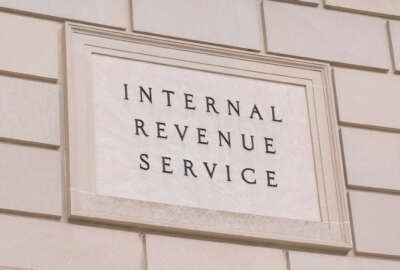How the IRS took this really big step toward digital service
An information technology team at the IRS has won recognition for a system that lets taxpayers submit correspondence online.
An information technology team at the IRS has won recognition for a system that lets taxpayers submit correspondence online. More than a quarter million pieces of mail have already been avoided and officials expect a rate of 125 million pieces of digital mail a year. For their work and its impact on tax-processing efficiency, they’re finalists in this year’s Service to America Medals program. The Federal Drive with Tom Temin visited with project director Wanda Brown, who spoke on behalf of the team.
Interview Transcript:
Tom Temin And we should acknowledge team members Darnita Trower and Gerald Johnson were cohorts with you in this particular project. It sounds like you took a capability that was existing already for internal IRS use and kind of turned it outward. Tell us more about what you did.
Wanda Brown Sure. We started off with ten notices that were directed to the taxpayer, and we were able to put a link on that notice and provide the taxpayer the capability to access that link and be able to send an uploaded version of their documentation directly to the IRS. Basically had the opportunity to take that capability and scale it. The IRS sends out about 3600 different notices and letters to the taxpayers. We were able to provide that capability through a link on the IRS.gov for a taxpayer to respond to any notice or letter that they receive from the IRS directly through uploading their documents.
Tom Temin Now that uploading was originally devised during the pandemic for employees.
Wanda Brown Yes, absolutely. We were able to receive correspondence from our employees during the pandemic. They were able to directly upload, and we took that capability and we expanded upon that significantly for the taxpayers use.
Tom Temin Now the taxpayer then gets a notice one of 3600 types of notices. I’m surprised it’s only 3600. And if their response is like a letter back to the IRS, then they presumably have to create that in a way that can be uploaded. What about the people that have to handwrite something? Can they scan it, or how does that work?
Wanda Brown They can handwrite it and they can scan it. They can take a picture of it and then upload it to the IRS.
Tom Temin They can use their phone actually, and take a picture of it.
Wanda Brown Absolutely.
Tom Temin Wow. And what was involved in expanding the upload and the server and the acceptance storage and all of this when you expanded from IRS employees, which is not a small number, about 10,000 people, I think to millions of potential taxpayers here.
Wanda Brown We were able to take advantage of the cloud technology, to be able to take advantage so that we would have the ability for the taxpayers to upload that image. We have a capability, and we were able to leverage it.
Tom Temin And a given taxpayer, is there a case file, let’s say, or a folder for each taxpayer such that somehow with a link that went to that taxpayer and whatever they upload is tied to their name or their Social Security number or something like that? How do you keep it all organized?
Wanda Brown We basically have the capability for the correspondence for that particular notice or letter to be uploaded, and it is housed in a, I’m going to call it buckets. It’s housed in a group of buckets. And we’re able to access that correspondence directly from the taxpayer.
Tom Temin We’re speaking with Wanda Brown. She is the project director for digital services and digitalization in the Wage and Investment Division of the Internal Revenue Service. I think I got that all right. And what about employees who would normally get piles of mail? And as we know, mail was a problem. Physical mail, postal mail for the IRS when people weren’t in the office. There must have been some retraining for people to read digital uploaded versions versus splitting open mail and unfolding it.
Wanda Brown Absolutely. We have a very easy to use user interface, and they’re able to get into the tool. And I’m going to characterize it in buckets. And they’re able to get into their particular set of notices that they’re looking for they’ve been assigned to work. They’re able to get into it. They’re able to identify the actual correspondence that they’re looking for and be able to use digital image.
Tom Temin And do the buckets have identifiers such that suppose someone says, okay, well check on this later. And another operator or another IRS person can open that bucket and see what’s happening.
Wanda Brown Absolutely. And once an operator has access to the particular set of correspondence, they can identify it and mark it as archived. That they’re using it, that they’ve already processed it. And that helps us with our inventory.
Tom Temin It seems like this would also enable more people to work more effectively at home or telework.
Wanda Brown It does provide that capability, because it is digital that they can access it from where they are working. So they can access it from the location where they have been assigned to work. And if that happens to be their home, they can do that as well.
Tom Temin Because in most federal situations, people are not allowed to take official correspondence and records to their homes. So when it’s not the piece of paper, then they’re okay accessing it in a digital format from the location of a PC.
Wanda Brown Absolutely. Being able to access that digitally allows some additional flexibility to accessing information.
Tom Temin All right. And give us some statistics. How extensively has this been used? I guess it was deployed in time for the most recent tax season.
Wanda Brown Yeah. So very recently we have had a milestone. We’ve had over a million submissions through the document upload tool that we hit that earlier this week. So that that’s a big milestone for us. We’re celebrating that. And we expect more word of mouth, more people being able to access and get the benefit from that tool.
Tom Temin And I guess I should have asked this in the beginning. When you send out a notice to a taxpayer, do you send it to them as paper, because email from the IRS could be suspect as to its authenticity?
Wanda Brown Right now, people still receive a physical paper notice from the IRS. Those that have an online account capability. We are working on the capability for them to receive notices and letters through their online account. But right now, for those that do not, they will receive a physical notice in the mail from the IRS.
Tom Temin So it would be wise then, for a given taxpayer to establish an account so that they know that notices coming through that account are genuine, almost like signing up for a doctor practices portal.
Wanda Brown Yeah, that capability for online account is out there. And we do have lots of taxpayers that take advantage of that. It is not mandatory, but it is definitely a feature that we have out there for our taxpayers.
Tom Temin And how does this help efficiency of tax processing.
Wanda Brown So how it helps with the efficiency of tax processing. If you think about, I’m going to speak just from the correspondence perspective, just being able to send that in digitally. We’ve already talked about how that allows our employees to access the data, digitally and then they’re able to process it. That is one of the things that we continue to focus on, so that when we get an end, we’re able to digitize that and digitalize it, that those are the things that we’re working on. We’re a little bit away from being able to send data downstream. That’s one of the goals. Our intent is for our taxpayers to be able to interface with the IRS, just like they do with any financial institution. And it’ll take us, we’ve got a roadmap to get there. It’s going to take us a while, but that is the goal.
Tom Temin And I would think this would help, like load balance among your workforce, because if you don’t have to deal with physical paper, that means you don’t have to be in the same zip code as the physical paper.
Wanda Brown It definitely provides additional flexibility on how we take in the work and how we process the work, and how we can shift the work. Definitely provide some additional flexibilities there. But I want to stress, there is some segment of our taxpayer community that prefer to send paper into the IRS, and that is okay. That is okay for them to do that. We are prepared to be able to receive their physical paper if they’re not able to use some of the digital services that will be putting out.
Discover more about how to elevate your customer experience in the “Excellent, equitable and secure customer experience: A closer look at high-impact service providers” series.
Copyright © 2025 Federal News Network. All rights reserved. This website is not intended for users located within the European Economic Area.
Tom Temin is host of the Federal Drive and has been providing insight on federal technology and management issues for more than 30 years.
Follow @tteminWFED






